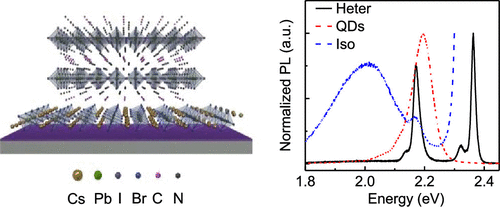当前位置:
X-MOL 学术
›
ACS Photonics
›
论文详情
Our official English website, www.x-mol.net, welcomes your
feedback! (Note: you will need to create a separate account there.)
Enhancing Self-Trapped Exciton Emission via Energy Transfer in Two-Dimensional/Quantum Dot Perovskite Heterostructures
ACS Photonics ( IF 6.5 ) Pub Date : 2022-05-25 , DOI: 10.1021/acsphotonics.2c00113 Wancai Li 1 , Long Hu 2 , Jiaqi Ma 1 , Chuanxiu Jiang 3 , Shuai Zhang 3 , Yingying Chen 1 , Junchao Hu 1 , Xinfeng Liu 3 , Tom Wu 2 , Dehui Li 1, 4
ACS Photonics ( IF 6.5 ) Pub Date : 2022-05-25 , DOI: 10.1021/acsphotonics.2c00113 Wancai Li 1 , Long Hu 2 , Jiaqi Ma 1 , Chuanxiu Jiang 3 , Shuai Zhang 3 , Yingying Chen 1 , Junchao Hu 1 , Xinfeng Liu 3 , Tom Wu 2 , Dehui Li 1, 4
Affiliation

|
Self-trapped excitons, which often occurs in materials with soft lattice and strong electron–phonon coupling, have attracted a lot of attention owing to their unique broadband emission and promising applications in persistent white light sources. However, the emission of self-trapped excitons is usually weak in some two-dimensional (2D) and three-dimensional (3D) perovskites because of their low radiative recombination rate. The existing strategies of enhancing the emission efficiency of self-trapped excitons such as metal cation doping and organic ligands modification often entail complex chemical synthetic processes. Here, we report a new approach to significantly boost the self-trapped exciton emission via the interfacial excitonic energy transfer in 2D/quantum dots (QDs) perovskite heterostructures. The self-trapped exciton emission in the heterostructures could be enhanced more than two orders of magnitude compared with the constituent 2D perovskite crystals. Temperature-, excitation power- and thickness-dependent photoluminescence (PL) studies reveal that the enhanced self-trapped exciton emission in the heterostructure can be ascribed to Dexter energy transfer taking place at the interface of the heterostructure. Our study provides a simple and practical interface-based strategy to improve the emission efficiency of self-trapped excitons for photoelectric devices.
中文翻译:

通过二维/量子点钙钛矿异质结构中的能量转移增强自陷激子发射
自陷激子通常出现在具有软晶格和强电子-声子耦合的材料中,由于其独特的宽带发射和在持续白光源中的应用前景而引起了广泛关注。然而,在一些二维(2D)和三维(3D)钙钛矿中,由于其低辐射复合率,自陷激子的发射通常较弱。现有的提高自陷激子发射效率的策略,如金属阳离子掺杂和有机配体修饰,通常需要复杂的化学合成过程。在这里,我们报告了一种通过二维/量子点 (QD) 钙钛矿异质结构中的界面激子能量转移显着提高自陷激子发射的新方法。与组成的二维钙钛矿晶体相比,异质结构中的自陷激子发射可以增强两个数量级以上。温度、激发功率和厚度相关的光致发光 (PL) 研究表明,异质结构中增强的自陷激子发射可归因于在异质结构界面发生的德克斯特能量转移。我们的研究提供了一种简单实用的基于界面的策略来提高光电器件自陷激子的发射效率。激发功率和厚度相关的光致发光(PL)研究表明,异质结构中增强的自陷激子发射可归因于在异质结构界面处发生的德克斯特能量转移。我们的研究提供了一种简单实用的基于界面的策略来提高光电器件自陷激子的发射效率。激发功率和厚度相关的光致发光(PL)研究表明,异质结构中增强的自陷激子发射可归因于在异质结构界面处发生的德克斯特能量转移。我们的研究提供了一种简单实用的基于界面的策略来提高光电器件自陷激子的发射效率。
更新日期:2022-05-25
中文翻译:

通过二维/量子点钙钛矿异质结构中的能量转移增强自陷激子发射
自陷激子通常出现在具有软晶格和强电子-声子耦合的材料中,由于其独特的宽带发射和在持续白光源中的应用前景而引起了广泛关注。然而,在一些二维(2D)和三维(3D)钙钛矿中,由于其低辐射复合率,自陷激子的发射通常较弱。现有的提高自陷激子发射效率的策略,如金属阳离子掺杂和有机配体修饰,通常需要复杂的化学合成过程。在这里,我们报告了一种通过二维/量子点 (QD) 钙钛矿异质结构中的界面激子能量转移显着提高自陷激子发射的新方法。与组成的二维钙钛矿晶体相比,异质结构中的自陷激子发射可以增强两个数量级以上。温度、激发功率和厚度相关的光致发光 (PL) 研究表明,异质结构中增强的自陷激子发射可归因于在异质结构界面发生的德克斯特能量转移。我们的研究提供了一种简单实用的基于界面的策略来提高光电器件自陷激子的发射效率。激发功率和厚度相关的光致发光(PL)研究表明,异质结构中增强的自陷激子发射可归因于在异质结构界面处发生的德克斯特能量转移。我们的研究提供了一种简单实用的基于界面的策略来提高光电器件自陷激子的发射效率。激发功率和厚度相关的光致发光(PL)研究表明,异质结构中增强的自陷激子发射可归因于在异质结构界面处发生的德克斯特能量转移。我们的研究提供了一种简单实用的基于界面的策略来提高光电器件自陷激子的发射效率。











































 京公网安备 11010802027423号
京公网安备 11010802027423号